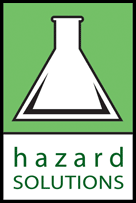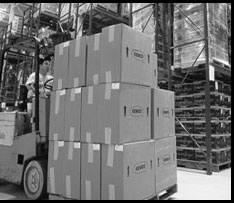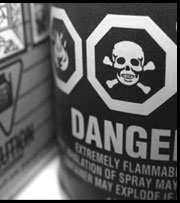DOT and IATA Dangerous Goods Updates in 2009
By: Arthur Mahoney, M.S., CHMM, REA
January 20, 2009
2009 has also brought about some important changes to the IATA
Dangerous Goods regulations (DGR) which may impact how you ship
dangerous goods* by air. In addition, primarily in an effort to
further harmonize Department of Transportation (DOT) regulations
with international regulations, there have been a number of
significant changes in the DOT hazardous materials regulations that
may impact you. I have summarized some of the changes below.
IATA DGR Changes in 2009:
- Here are some changes in the 2009 DGR that may impact you.
"Excepted Quantity" label has changed (new label below). Include the class/division and the name of the shipper on the new label.

- The "List of Dangerous Goods" contains a new "Excepted Quantity" column with codes E0 through E5 for quickly looking up limits for the inner containers and complete package in the revised and greatly simplified Table 2.7.A. In my opinion this is a great improvement.
- In Packing Instruction 602 (Infectious Substances, Cat A), the term "water-tight" has been revised to "leak-proof" to make the terminology in this packing instruction consistent with Packing Instruction 650 (Biological Substance, Cat B).
- 5 new Packing Instructions for lithium batteries. These have not been adopted by DOT.
- Clarification that the UN specification markings on packagings inside an overpack are not to be reproduced on the outside of the overpack.
- Many other changes to entries in the "List of Dangerous Goods" and elsewhere.
- Make sure you obtain a copy of the 2009 DGR and that your
employees are up to date in their DGR training (every 2 years).
DOT Changes in 2009:
The final rule 74 FR 2199 was published on January 14, 2009. If you want to read the changes, set aside several hours, the document is 70 pages long. I did the reading and have summarized some of the changes that I believe may impact you:
- Small Quantity Exception:
- Creation of new section 49 CFR 173.4a for "excepted quantity" for air and vessel transport. This makes the DOT requirements consistent with the DGR and IMDG code. The new "Excepted Quantity" label (shown above in previous section) has also been incorporated into the regulations. A notable difference between DOT and DGR is that the statement "Dangerous Goods in Excepted Quantities" is only required if a document such as an air waybill accompanies a shipment.
- Section 173.4 has stayed the same, but now only pertains to highway and rail. Also packages must include a new marking: "This package conforms to 49 CFR 173.4 for domestic highway or rail transport only." No shipping paper is required.
- Creation of new section 49 CFR 173.4b for small quantity de minimis (less than 1 gram for solids and less than 1 milliliter for liquids per inner packaging) transported by all modes. No marking or shipping documentation required. Note: this regulation for "de minimus" quantites was published in 2008 and became effective in October 1, 2008.
- Many changes in the Hazardous Materials Tables and Special Provisions.
- Class 9 label may now include (or not include) a horizontal bar. Again this was to align DOT with international regulations.
- The Cargo Aircraft Only label has been changed; however, the current label may still be used until January 1, 2013. Again this was to align DOT with international regulations.
- For Infectious Substances, Cat A, the term "water-tight" has been revised to "leak-proof" to make the terminology in this packing instruction consistent with the Biological Substance, Cat B requirements and international regulations.
- Shipping batteries, including those contained in equipment. If you ship batteries, new hazard communication requirements may now apply. Also incident reporting is required for batteries.
- Dates to note:
- Voluntary compliance date: 1/1/09
Effective date: 2/13/09
Delayed compliance date: 1/1/10 - Make sure your employees are up to date in their DOT training (every 3 years).
Lithium Battery Reminder:
As of January 1, 2008, in traveling by air, spare lithium
batteries can not be placed in checked in baggage. Remind your
employees who travel for work that if they carry a spare lithium
battery - it must not be in their checked in luggage. Since
1996, there have been 96 reported incidents due to batteries.
Proposed Security Plan changes in 2008:
Just a heads up that PHMSA, in consultation with the
Transportation Safety Administration (TSA) of the Department of
Homeland Security (DHS), is proposing to modify its current security
plan requirements governing the commercial transportation of
hazardous materials by air, rail, vessel, and highway. Based on an
evaluation of the security threats associated with specific types
and quantities of hazardous materials, the proposed rule would
narrow the list of materials subject to security plan requirements.
Training Requirements
Who Must be Trained:
Is everyone who is required to be trained at your company actually
trained? Very often, Shipping and Receiving personnel are tasked
with shipping dangerous goods packages which they did not personally
package. Laboratory personnel without the proper training may have
packaged the material- potentially putting your company at risk. Per
49 CFR and HM-223**, training must be provided to employees who
affect hazardous materials/dangerous goods* transportation safety.
This includes employees who:
- Determine a material's hazard class(es);
- Select the packaging;
- Fill and close a packaging;
- Mark and label a package;
- Prepare or review shipping papers and emergency response information;
- As an importer of hazardous materials/dangerous goods*, provide the shipper with shipping requirements that will apply to the transportation of the material within the United States;
- Certify that a hazardous material/dangerous good* is in proper condition for transportation;
- Load, block, and brace a hazardous material/dangerous good* package in a freight container or transport vehicle;
- Segregate a hazardous materials package in a freight container or transport vehicle from incompatible cargo.
- Selecting, providing, or affixing placards for a freight container or transport vehicle to indicate that it contains a hazardous material/dangerous good*.
How Often is Training Required:
Initial training is required within 90 days of the job
function. Retraining is required with 24 months (air) and
36 months (highway) of initial training. Additionally, employees
must be retrained when there are changes in the regulations which
impact them.
What is the Required Content of the Training:
- General familiarization training
- Function-specific training
- Safety training
- Security awareness training
Testing and Certification:
Employees must be tested and certified. But the testing can (and
should) be customized to the functions of the employee.
Our Training Solution
Focused on What You Ship:
Save money and time. You do not need to send your employees to
offsite training courses which may last three days! The program I
offer can often be completed in a single 1-day session at your
facility. In addition, the testing and certification can also be
customized to the specific job functions.
Added Value: Your Very Own Shipping Guidelines:
Included in the training are shipping guidelines/checklists
customized to the types of materials you actually ship. These
may also include procedures and forms for carriers that you use
(e.g., FedEx, World Courier, DHL). These are included in a
customized manual for your shipping personnel.
More Added Value: Packaging Solution Consultation:
Working with a number of packaging vendors over the years, I can
assist your organization in developing customized packaging
solutions.
An Easy Way to Comply
Contact me and I would be happy to provide you a quotation for
dangerous goods/hazardous materials training program.
What makes my program especially valuable is that it is specific to
the dangerous goods/hazardous materials that you ship and it is
presented by me, an expert in the field.
Other commonly requested services include:
- Chemical safety audits and training
- Onsite and special project support
- HMBP and chemical inventory services
- Hazardous waste auditing, minimization and reporting
- Bloodborne Pathogens (annual requirement)
- Hazard Communication
- Chemical Hygiene Plan
- General Safety
- Laser Safety
- Biological Safety
- Radiation Safety
- Many others, please contact me
Served by an Expert in the Field
My credentials include:
- 17 years of experience assisting public and private companies to comply with environmental and safety laws and regulations
- Educator of safety professionals
- MS in chemistry from University of California, Berkeley
- Certified Hazardous Materials Manager (Masters Level)
- Registered Environmental Assessor
Kind Regards
Arthur Mahoney, MS, CHMM, REA
Hazard Solutions LLC
326 Sonora Drive, San Mateo, CA 94402
email: art@hazardsolutions.com
website: http://www.hazardsolutions.com/
Software website: http://www.hazardsolutions.com/software/
--EHS Compliance, Training
and Data Management Solutions—
*Dangerous goods includes articles or substances
which may be hazardous (in air transport). The definition of
dangerous goods is found in the Dangerous Goods Regulations,
published by the International Air Transport Association (IATA) .
Dangerous goods are synonymous to hazardous materials, which is the
term used to describe hazardous substances in 49 CFR.
**HM-223 clarifies the many pre-transportation functions which
necessitate training.
Disclaimer: The information presented above should not be construed in any way as legal advice or an interpretation of regulations. It is meant to provide basic information about topics that may affect clients and colleagues.



